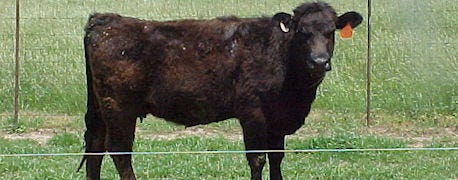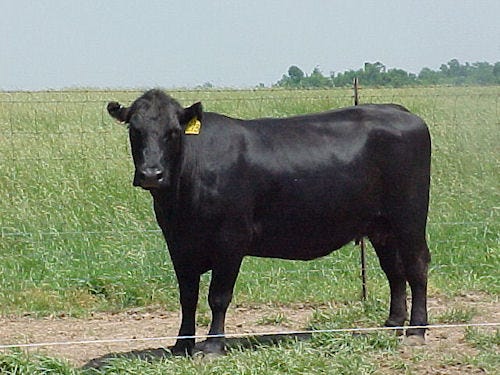July 16, 2012

Now is a good time to look your beef cows over closely to determine who is shed their winter coat and who is not according to Eldon Cole, a livestock specialist with University of Missouri Extension.
"Ideally, all cows should be as slick as moles by mid-June or even by mid-May. However, some cows are slow shedders," said Cole.
The slow shedders are more prone to heat stress and high body temperatures. These problems result in slower gains, lower milk output for nursing calves and poorer reproductive rates. All-in-all they tend to be less profitable.
Slow shedders can even have more exaggerated hair problems if they are grazing endophyte infected, toxic fescue according to Cole.

Cattle with a hair like this one, have a hair score of a 3 or 4. These cattle may be slower to put on pounds.
"Since fescue is the dominant forage in southwest Missouri, we seem to have become accustomed to seeing cattle with unusually long haircoats this time of year. Excessive hair is viewed as a liability in the summer on feeder cattle as most feedlots are not well equipped to handle long haired, heat stress prone cattle," said Cole.
Hair shedding is a moderately heritable trait at 0.35. Persons wishing to select for early shedding should be able to make progress. Those with "hot" fescue pastures that produce high levels of the ergot-like toxins, should find this selection pressure worthwhile.
~~~PAGE_BREAK_HERE~~~
However, some cow-calf producers prefer cattle that grow hair and hold on to it. Examples would be those who show cattle or sell club calves.

Cattle should be slick, or have a hair score of A 1, by the end of June.
Researchers use a scoring system to keep track of shedding. Cole says it is a good tool to use when monitoring your own heard. A 1 score is very slick and shiny. A 2 is mostly shed off. A 3 is half shed off. A 4 is just beginning to slip hair along its topline and the fore part of its body. A 5 score indicates no signs of hair shedding.
"Your hair observations may not be that precise just as long as you can document who sheds early and who doesn't," said Cole. "Not only is hair shedding heritable, it seems to be repeatable from year-to-year. Some breeds definitely slick off earlier and nutritional and health factors may influence shedding rates."
Cows calving in the fall months may hold their hair a little longer than spring calvers, but normally slick off as soon as their calves are weaned. Cole says this is especially noted if they're on "hot" fescue.
There are numerous traits cattle breeders consider when making breeding decisions. Those traits should be highly economical such as growth, carcass merit and milk production. Cole says perhaps the ability to shed early should be added to that list.
"Some AI sire directories mention early shedding as a favorable trait but there is not an expected progeny difference (EPD) for it at this time," said Cole.
Source: University of Missouri Extension
You May Also Like




